We look at property in today’s Money Morning.
I’m trying to figure out if the slowdown we’ve seen over the summer is just that – a slowdown, a pause before the next leg higher; or if it’s the start of something more ominous.
There has been plenty of food for the bears – one morsel that surprised me yesterday was Grand Designs presenter Kevin McCloud urging people to rent, not buy.
This came on the same day as a nice dish was served up for the bulls. The Office for National Statistics announced that prices in the East Midlands, the West Midlands and the South West have joined London, the South East and the East of England in exceeding their pre-financial crisis highs.
So let’s examine some bellwethers and ask, ‘Who’s got it right?’
Foxtons’ slide points to a London slowdown
We start with some succulent food for the bears. Exhibit A – Foxtons and London.
As London’s most famous estate agent, Foxtons (LSE: FOXT) is an obvious barometer for property in the capital. The company listed on the stock market in August 2013 at 230p – a price which an estate agent might describe as ‘fully valued’ – and ended its first day’s trading at 270p. By March of this year, it was almost touching 400p.
But since then it’s been falling. I wrote about the company back in late July and by then it had fallen back to that key 260-270p level. It had a bounce, but the falls soon resumed. This week a big level was breached.
It fell below its listing price.
This means that everyone who now owns the stock after the listing is underwater. What kind of risk management do they have? Where are their stops?
Here’s the chart. I’ve defined the trend with two black tramlines – not that it needed much defining.
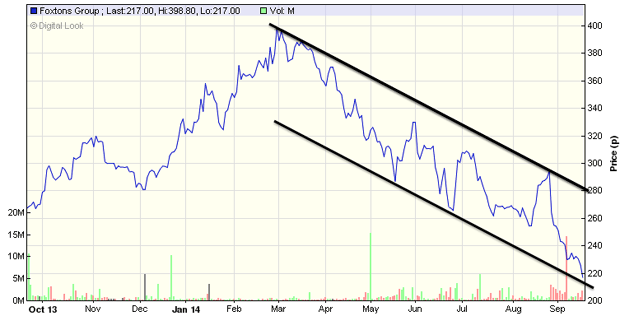
I should say that it’s right at the bottom of that range, so it could easily rally here. Apart from outright declines, what the bears would like to see is a rebound to the listing price of 230p, or even 260p, a failure at those levels, and then the declines to resume.
Foxtons’ model is to secure instructions by pricing houses higher than their rivals. As well as sexy marketing, they then hope that prices catch up with the valuations – which, London property being what it is, they usually do. It’s an aggressive strategy that works beautifully in a bull market, but if valuations get too far ahead of themselves, Foxtons can be left dry.
London is no longer a sellers’ market
That’s the problem that it – and every other London agent – is having now. Buyers are not meeting the extreme valuations in the way that they were six or nine months ago. Turnover has slowed.
Looking randomly through the SW postcodes’ sales volumes on Rightmove, completed sales are markedly down on the highs of late 2013 and early 2014. The worst performers are SW6 (Fulham), SW8 (Vauxhall), SW9 (Clapham North), SW12 (Balham), SW13 (Barnes) and SW20 (West Wimbledon). In some cases, completed sales are down by 50%. For Foxtons and others, that’s a 50% drop in turnover.
Rightmove only has data up to May. Statements from agents and surveyors suggest the slowdown may even have got worse over the summer. It’s also worth noting that, at the same time, there is more property for sale than there was a year ago – in some cases stock has doubled. Vendors are attracted by the high asking prices.
For completions to increase, either more money needs to come from somewhere – be it in the form of cash or credit – or prices need to fall.
Given that foreign buyers are down, and regulatory measures such as the Mortgage Market Review (MMR) have led to a tightening of lending, my instinct is to go with the latter. Already, agents are reporting that asking prices have fallen by 6-10%. There is an excellent thread on the forum housepricecrash.co.uk in which participants are monitoring falls in London asking prices on a daily basis. We’re seeing reductions every day. This is not a crash – not by any means – asking prices have fallen from the insane to the dotty, nothing more – but they are coming down.
The rest of Britain isn’t so bearish
From London’s most famous agent to the country’s largest – Countrywide (LSE:CWD). Countrywide Group listed in March 2013 at 350p and was 15% higher by the end of its first day’s trading. The bull market would continue until March of this year when it reached 700p. Then – just as with Foxtons – the declines began.
It hit a low of 460p in the summer and then rallied. It now looks like it’s turned back down again, though at its current price of 480p, it’s still sitting above its summer lows. I see 460p as pivotal. A break below that and 400p beckons, even the 350p listing price – at which point there is a risk of it ‘doing a Foxtons’.
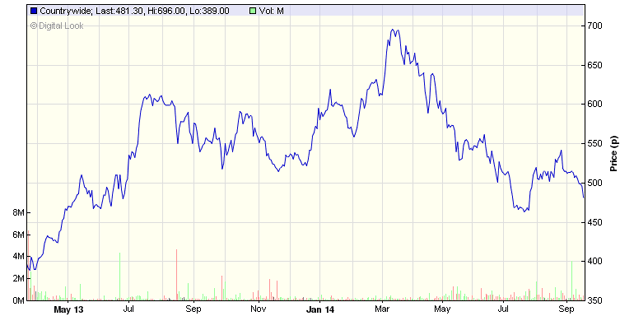
I was at a dinner last night for a bunch of fund managers. I had two different technical analysts look at that chart independently of each other. For what it’s worth, they were both bearish.
The case for house prices to keep rising
So let’s move on to some bull food.
Our starter is Savills (LSE:SVS). It has held up much better than Foxtons or Countrywide. It enjoyed a long run up from 2011 to 2013 and over the last year it has been in a range from 580p to 680p. At 620p, it’s now in the middle of the range. It might be consolidating before the next move higher, it might be rolling over – the jury is still out – but it’s not even 10% off its highs. Bulls can look to Savills, and say Foxtons’ problems are company specific.
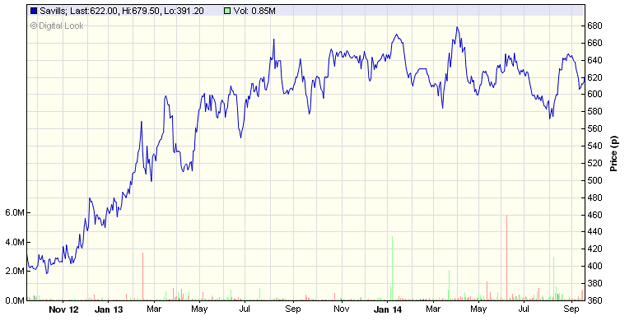
From the agents to the builders. Barratt (LSE:BDEV) is the country’s largest, and it’s another barometer for the property market, as I’ve argued before. The bulls will be feasting on Barratt’s price action. From its 2011 low of 68p, it rose some five times to a peak of 450p this March. At 390p it is off its highs, but the uptrend is still intact and strong. Those same technical analysts who were bearish on Countrywide were bullish about Barratt.
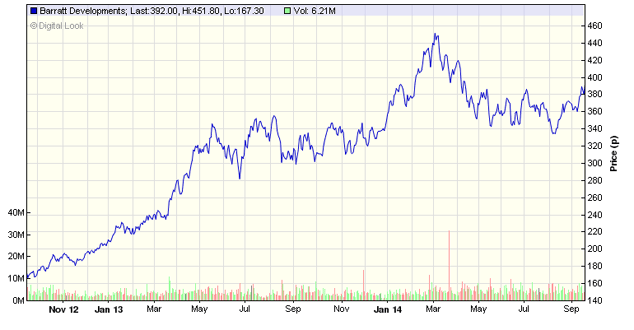
And last but not least, the bulls’ plat du jour – the entire household goods and home construction sector. It broke to new highs this week – above the highs of March when most of the builders and estate agents peaked.
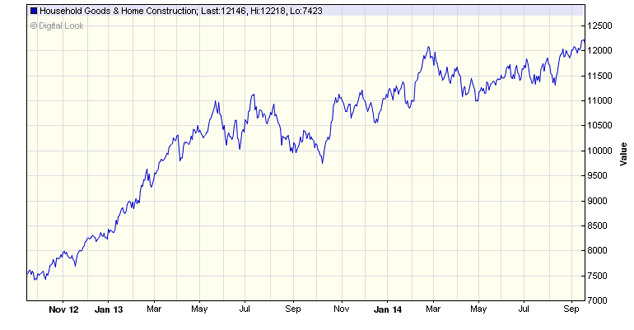
So, there are conflicting messages.
My superficial interpretation of it all would be to suggest that the gap between London and everywhere else might be starting to close. London property is slowing, no doubt. But Foxtons (and perhaps Countryside) aside, the barometers are not saying ‘crash’. For now, I’m going with the interpretation that price rises will not be so dramatic in the second half of this year as they were in the 12 months to last April. They may even fall.
But who knows what today’s Scottish referendum vote will bring? My prediction, by the way, is that it’ll be a No, by 53-4% to 46-7% – but we’ll see. It’s very exciting indeed – the first election I’ve ever known that could actually bring real change. Whatever you decide, Scotland – I wish you good luck.
Finally, the digital version of Bitcoin: the Future of Money? is now with us. If you supported the book, you get a copy – no matter which level you pledged at. To get yours, visit this page and download your copy. There are PDF, ePub (for iBooks) and mobi (for kindle) versions. You’ll need to be logged in.
Category: Market updates

